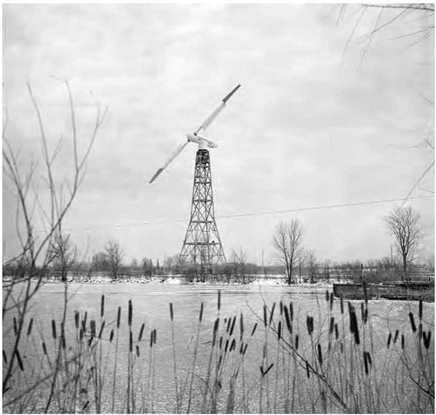NASA-Industry Wind Energy Program Large Horizontal-Axis Wind Turbines
The primary objective of the Federal Wind Energy Program and the specific objectives of NASA’s portion of the program were outlined in a followup technical paper presented in 1975 by Thomas, Savino, and Richard L. Puthoff. The paper noted that the overall objective of the
program was "to develop the technology for practical cost-competitive wind-generator conversion systems that can be used for supplying significant amounts of energy to help meet the nation’s energy needs.”[1499] The specific objectives of NASA Lewis’s portion of the program were to: (1) identify cost-effective configurations and sizes of wind-conversion systems; (2) develop the technology needed to produce cost-effective, reliable systems; (3) design wind turbine generators that are compatible with user applications, especially with electric utility networks; (4) build up industry capability in the design and fabrication of wind turbine generators; and (5) transfer the technology from the program to industry for commercial application. To satisfy these objectives, NASA Lewis divided the development function into the three following areas: (1) design, fabrication, and testing of a 100-kilowatt experimental wind turbine generator; (2) optimizing the wind turbines for selected user operation; and (3) supporting research and technology for the systems.
![]() The planned workload was divided further by assignment of different tasks to different NASA Research Centers and industry participants. NASA Lewis would provide project management and support in aerodynamics, instrumentation, structural dynamics, data reduction, machine design, facilities, and test operations. Other NASA Research Centers would provide consulting services within their areas of expertise. For example, Langley worked on aeroelasticity matters, Ames consulted on rotor dynamics, and Marshall provided meteorology support. Initial industry participants included Westinghouse, Lockheed Corporation, General Electric, Boeing, and Kaman Aerospace.
The planned workload was divided further by assignment of different tasks to different NASA Research Centers and industry participants. NASA Lewis would provide project management and support in aerodynamics, instrumentation, structural dynamics, data reduction, machine design, facilities, and test operations. Other NASA Research Centers would provide consulting services within their areas of expertise. For example, Langley worked on aeroelasticity matters, Ames consulted on rotor dynamics, and Marshall provided meteorology support. Initial industry participants included Westinghouse, Lockheed Corporation, General Electric, Boeing, and Kaman Aerospace.
In order to undertake its project management role, NASA Lewis established the Center’s Wind Power Office, which consisted initially of three operational units—one covering the development of an experimental 100-kilowatt wind turbine, one handling the industry-built utility-operated wind turbines, and one providing supporting research and technology. The engineers in these offices basically worked together in a less formal structure, crossing over between various operational areas. Also, the internal organization apparently underwent several changes during the program’s existence. For example, in 1976, the program was
 |
|
directed by the Wind Power Office as part of the Solar Energy Branch. The first two office managers were Ronald Thomas and William Robbins. By 1982, the organization consisted of a Wind Energy Project Office, which was once again under the supervision of Thomas and was part of the Wind and Stationary Power Division. The office consisted of a project development and support section under the supervision of James P. Couch (who managed the Mod-2 project), a research and technology section headed by Patrick M. Finnegan, and a wind turbine analysis section under the direction of David A. Spera. By 1984, the program organization had changed again with the Wind Energy Project Office, which was under the supervision of Darrell H. Baldwin, becoming part of the Energy Technology Division. The office consisted of a technology section under Richard L. Puthoff and an analysis section headed by David A. Spera. The last NASA Lewis wind energy program manager was Arthur Birchenough.










